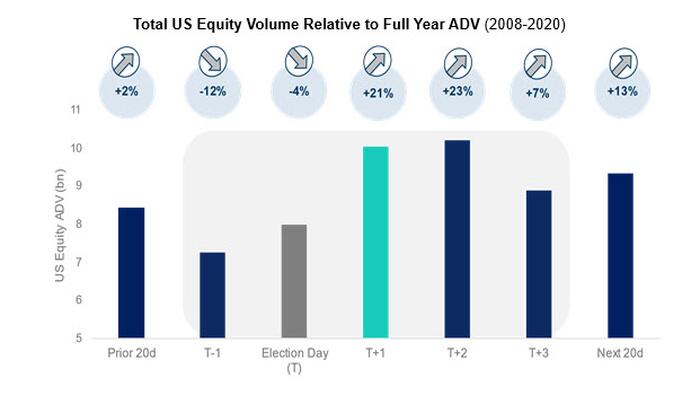In the lead-up to tomorrow’s election day, there is a notable dichotomy in the market sentiment regarding implied volatility. On one hand, the implied volatility is one of the lowest recorded values, indicating a sense of calm or reduced fear among traders about upcoming market fluctuations. Such low levels of implied volatility can reflect a lack of anticipation for significant market movements, which is particularly striking given the unpredictable nature of electoral outcomes. The market typically sees heightened volatility around major events like elections, but in this instance, the implied volatility suggests a possible underestimation of risks.
Conversely, hedge funds are reacting to this low implied volatility by making substantial cuts to their gross exposure in the markets. This behavior may reflect a cautious approach, as these funds reevaluate their positions in light of the current political landscape. The decision to reduce exposure could stem from a strategic standpoint, where funds prefer to limit potential losses during uncertain times. This reduction in risk appetite might also signal that hedge funds are positioning themselves defensively, perhaps in anticipation of sudden market shifts that could arise from unexpected electoral results.
Moreover, Long Only funds have taken even more pronounced steps, outright selling off assets. This indicates a broader sentiment of caution as these funds prioritize capital preservation over potential gains. The concern regarding market liquidity is a significant factor in this decision, as there are apprehensions that high volatility and uncertain outcomes could lead to a rapid evaporation of liquidity. Such a scenario could make it challenging for these funds to exit positions quickly or at favorable prices if the market turns against them, heightening their risk exposure.
The backdrop to this cautious market behavior is the uncertainty surrounding the electoral process. Neither candidate is perceived as a guaranteed winner, which adds an additional layer of unpredictability. This ambiguity can lead to volatility, as markets often react sharply to unexpected news or outcomes. The lack of a clear frontrunner might exacerbate concerns among institutional investors, prompting them to implement more conservative strategies amidst fears of a polarized electoral outcome.
Furthermore, the reduction in gross exposure and the selling action from Long Only funds could also reflect a broader trend within the financial markets towards risk aversion. As investors face a confluence of factors that could impact the market, including potential policy shifts, economic indicators, and international events, their decision-making is influenced by a desire to mitigate risks. Heightened awareness of these risk factors might lead investors to question whether the historically low implied volatility can adequately capture the potential for market upheaval in the event of a contentious or close election result.
In conclusion, the current environment surrounding tomorrow’s election day showcases a complex interplay between low implied volatility and cautious positioning by institutional investors. On one side, the low levels of implied volatility might suggest complacency or confidence in pre-election stability; on the other, hedge funds and Long Only funds are acting to shield themselves from potential upheaval by reducing exposure and selling assets. As the election unfolds, market participants will be closely monitoring liquidity conditions and potential market reactions, aware that the unpredictable nature of elections can lead to rapid shifts in sentiment and positioning in the financial markets.

